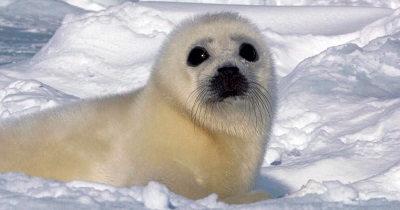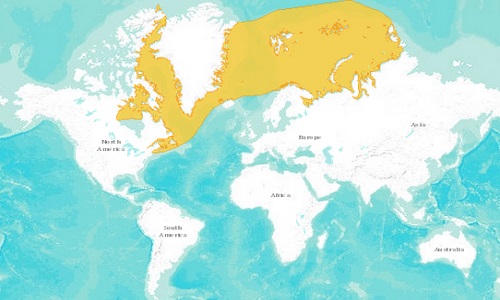Taxonomy
-
- Kingdom: Animalia
- Phylum: Chordata
- Class: Mammalia
- Order: Carnivora
- Family: Phociadae
- Genus: Pagophilus
- Species: Pagophilus Groenlandicus
0
0
Name
- Common name: Harp seal or Greenland seal.
- Scientific name: Pagophilus Groenlandicus
Distribution and Habitat
- The harp seal (Pagaphilus groenlandicus) is a marine mammal that lives in defined breeding grounds in the Arctic.
- There are three populations. The largest is the Western North Atlantic located in eastern Canada. The second group breeds on the “West Ice” on the eastern coast of Greenland. The third population breeds on the “East Ice” in the White See off the coast of Russia.

Harp seal distribution map. Source: IUCN Red List of Threatened Species
Physical Features
- Harp seals are part of the family Phociadae known as the true or earless seal because they lack the external ear flaps.
- They are sometimes called saddleback seals because of their dark saddle like marks on their back.
- Adult harp seals have silvery-gray body and its eyes are black. Pups have yellow-white coat when they are born and after 3 days its fur turn white for about 12 days.
- A thick coat of blubber insulates its body and provides energy when food is scarce.
Size and Weight
- These animals can grow up to 5 to 6 feet long or 1.7 to 2 meters and weight from 300 to 400 lbs or 140 to 190 kg.
Diet
- They eat fish and invertebrates.
Predators
- Harp seals are prey for killer whales, sharks and polar bears.
Social Behavior
- Harp seals are very social animals and form large colonies when they migrate.
Migration
- Outside their breeding season they migrate about 2,500 miles or 4,000 km.
- Harp seals spend most of their time swimming in the North Atlantic and Arctic Oceans and spend relatively little time on land.
- Each year they return to Newfoundland, the Greenland Sea and the White Sea where they find their mates.
Life Expectancy
- Harp seals live an average of 20 years in the wild.
Breeding
- Once a year they return to breeding grounds where they mate.
- Females gather in groups to give birth.
- Pups are usually born from late February to mid March and they nurse on high fat milk for about 12 days after which they are abruptly weaned and left on their own. Pups can lose half their body weight before they enter the water and begin feeding on their own.
- After females abandon their pups they start mating again.
- Females go through delayed implantation meaning that embryos do not attach to the uterine wall for 3 months or more.
- After breeding season, adults assemble and molt before migrating north to the Arctic in the summer season.
Threat
- Their main threat is humans and the loss of ice which represents a potential threat to their habitat.
- Inuit people in Canada hunt harp seals mainly for food. The Canadian seal hunt is monitored by the Canadian government.
Conservation Status
- The IUCN Red List of Threatened Species lists the harp seal as “Least Concern”.
Did you know?
While hunting, harp seals can hold their breath for up to 20 minutes. They can dive to depths of 800 feet or more.